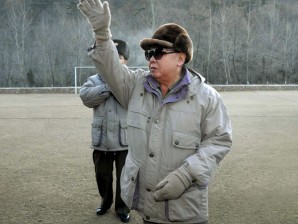SEOUL, Korea—North Korea is expected to mobilize hundreds of thousands of mourners for Wednesday’s funeral of late leader Kim Jong-Il, as the world watches for clues to future powerbrokers in the nuclear-armed nation.

This undated picture, released from North Korea's official Korean Central News Agency on December 14, 2011 shows North Korean leader Kim Jong-Il inspecting a firing drill of the Korean People's Army Unit 966 at undisclosed place in North Korea. North Korean state media confirmed on Monday that Kim died on December 17 at 8:30 am. He was 69. AFP PHOTO / KCNA VIA KNS
Pyongyang’s state media has so far given no details of the planned event, and foreign guests are barred.
But analysts expect largely a re-run of the 1994 obsequies for Kim’s father and founding president Kim Il-Sung—a ceremony designed to pay homage to the late leader and build loyalty to his dynastic successor.
“The outpouring of grief in 1994 was prevalent throughout Pyongyang, with almost all citizens out to bid farewell to their leader,” Yang Moo-Jin of Seoul’s University of North Korean Studies told AFP.
“The grief for Kim Il-Sung was genuine, with many people expressing real sorrow. The mood this time appears to be slightly different,” Yang said.
“The regime used the 1994 funeral to strengthen public allegiance and loyalty to new leader Kim Jong-Il. His own funeral this week will be staged in a similar way.”
The communist state has proclaimed Kim’s youngest son Jong-Un the “great successor” since his father died on December 17 aged 69.
But while Kim Jong-Il had 20 years to prepare for his takeover, Jong-Un has had barely three. Analysts are seeking clues about who will have most influence with the untested son, only in his late 20s.
“Old-time Kremlinologists will have a field day figuring out who is standing where and what it all means,” Ralph Cossa, president of the Pacific Forum CSIS, said of Wednesday’s funeral.
The North declared 10 days of national mourning after Kim Il-Sung died aged 82 on July 8, 1994.
State media depicted scenes of feverish collective grief for him, as it has for his son, with long lines of mourners in front of statues and portraits.
On the day of the funeral two million people were said to be lining the streets of Pyongyang, many of them weeping.
Kim Jong-Il, dressed in a dark blue Mao-style suit, had presided over mourning rites as his father lay in state in a glass coffin similar to the one now on display.
After the son paid his last respects, the coffin—draped with a red flag and mounted on a black limousine—left the Kumsusan Memorial Palace where the son’s body is also displayed.
The cortege was headed by a truck carrying a military band, followed by a huge portrait of Kim Il-Sung mounted on a car and a fleet of black Mercedes. They drove past an honour guard to the rumble of a gun salute.
Kim Jong-Il did not take part in the funeral motorcade, which lasted more than three hours.
The procession made its way past landmarks such as Mansudae Hill — on which stands a towering statue of Kim Il-Sung — and the Arch of Triumph Square before returning to the palace.
During the mourning period, Kim Jong-Il reportedly received a loyalty oath from eight million schoolchildren and other young people who journeyed across the country to pay homage to the late president.
“We’re going to see a highly public presentation of grief. People will be in tears. It will be very loud, expensive and solemn,” said Andrei Lankov of Seoul’s Kookmin University.
“We are likely to see, of course, his son who is going to become the next dictator.”
Jong-Un, who bears a marked resemblance to his grandfather, has led the mourning for the past week, weeping at one point before his father’s coffin and solemnly clasping the hands of visitors.
Kim Jong-Il’s two other sons are conspicuous by their absence. They are not listed as members of the official funeral committee and have not been pictured during the mourning period.
“Omitting the other offspring provides a straight and clean succession path from Kim Jong-Il to Kim Jong-Un,” wrote Roger Cavazos, an associate of the Nautilus Institute think-tank.